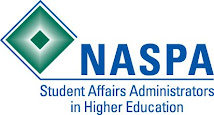NASPA is its members. You hear that every day in NASPA.
And it is true. The 11,000+ graduate students, new professionals, seasoned professionals, vice presidents, and former student affairs professionals that make up NASPA is what this organization is all about. It’s about bringing all of these people together to provide support, resources, and professional development for each other, to ensure that we all perform to our highest capability in what it is we do: foster holistic growth of our students. To do all of this, NASPA has a board of directors, a staff, and thousands of volunteers implementing a countless array of programs and services.
The People
NASPA is governed by a 22-person board of directors. The board is made up of regional vice presidents, division directors, members-at-large, the Foundation president, the annual conference chair, and the executive committee. The executive committee, the leading group of the board and NASPA, consists of the president, the past president, the president-elect, and the top two members of the NASPA staff (the executive director and the associate executive director). The president of NASPA is a three-year term – the first year you serve as president-elect, shadowing the president and learning everything you need to know. The second year you serve as the president, and the third year you serve as the past president, providing the president with support and guidance. This three-year program helps to provide an effective and smooth transition.
The regional vice presidents oversee each of the seven regions. The country is broken into seven regions, each region having their own conferences and programs. This allows for strong grassroots efforts, making the association feel smaller and more close-knit on the local level. You often hear NASPA leaders call the regions the “heart” of NASPA – as it’s the through the regions that one is really able to help shape and impact the association.
Divisions are areas of particular focus that the board wants to focus on. NASPA has six divisions, each one led by the division director. These divisions include knowledge communities (these are 21 topical focused groups that members can join), research, small colleges and universities, public policy, professional standards, and community colleges.
These board of directors, division directors, and hundreds of other volunteers are just that – volunteers. These are new professionals, seasoned professionals, and chief student affairs officers, all with full-time campus jobs. Therefore, the people of NASPA also includes the NASPA staff. 21 full-time professionals make up the staff of NASPA’s national office, located in Washington, D.C. These professionals, many of which have years of distinguished backgrounds in student affairs, work to implement the vision of the board and the members, as well as exist to help support and advise the board and members.
Professional Development, Policy, Advocacy
These are the three things that NASPA does. Professional Development, Policy, Advocacy. The association does this day in and day out, and does it all aligned with the NASPA mission.
Professional development is what we as student affairs professionals need and should seek out in order to be lifelong learners and always knowledgeable of the latest issues and best practices of the field. NASPA is where we can turn for this! In addition to the overwhelming array of conferences and workshops NASPA sponsors (and yes, there are many more conferences throughout the year than just the annual conference), professional development also entails a large array of publications. Publications include books, research articles, journals, newsletters, magazines – all of which cover the latest topics and research of the profession and are published by NASPA.
With the national office located in Washington, D.C., NASPA has a unique opportunity to influence legislature policy that influences higher education and specifically student affairs. In addition to the policy division, NASPA employs a full-time public policy specialist, as well as contracts out a lobbyist. This allows NASPA to stay on top of any new policy that may influence our profession and gives us the chance to step-in and provide the student-affairs perspective on the Hill. More on this in a later blog, possibly!
And finally, NASPA serves as an advocate for our profession. You will see the slogan “The Leading Voice for Student Affairs Administration, Policy, and Practice” branded on many of the associations materials. This pretty much sums up everything this organization does! NASPA primarily exists to promote the student affairs profession and the development of the whole person during an individual’s collegiate experience. Gwen Dungy, executive director of NASPA, spends most of her time traveling throughout the country speaking on the profession. Her main responsibility is to be that “voice” of the profession. She not only educates and enhances the life-long learning of current student affairs professionals, but she also talks to non-student affairs constituents, spreading the word about what we do to gain support for our endeavors.
Professional Development, Policy, and Advocacy. So, for those of you who may have thought that NASPA was an annual conference that happens every March (I may have been one of those myself at one time), think again. NASPA is about a lot more than just one conference!
Monday, June 16, 2008
Subscribe to:
Comments (Atom)
